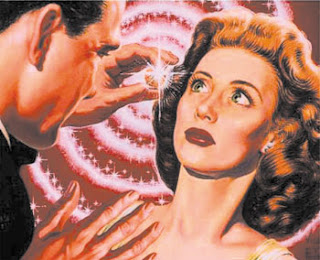I will watch almost anything with a paranormal/UFO theme to it, even paranormal reality shows, even the Ancient Aliens series on the History Channel.
I also have fond memories of the release of the first Von Daniken book, Chariots of the Gods!
You have to like a guy who isn't ashamed to use exclamation marks at the end of every sentence, no matter how silly or far-fetched.
Wait. What I meant to say is,
You have to admire a guy who isn't afraid! To use exclamation marks! At the end of every sentence! No matter how silly or far-fetched!
I also really, really like the Greek fellow with the crazy hair who edits his own magazine about this stuff. He is always very well-dressed and well-spoken, and he has hair that defies the laws of physics. Seriously, that hair is proof enough for me of almost anything he has to say.
I know I'm being a bit of smart aleck here and I usually try not to do that. But it seems to me that there are a number of basic misconceptions underlying the ancient alien hypothesis. Un-coincidentally, mainstream archeology shares a few of these too. That way, we get the classic crackpot/debunker deadlock polarity that for some reason HAS to emerge in any discussion of the unexplained.
Here are just a few of those (for my money) faulty assumptions:
- The Myth of Progress. This myth has it that human beings are naturally progressing toward greater and great sophistication and intelligence, so that anything in the deep past that we can't replicate and improve upon today must be evidence of some kind of intervention by a superior force. We can't build Stonehenge without machines so aliens must have done it. We can't build a system of aqua ducts to Roman specifications so aliens must have done it. We don't know how the Pharoahs slapped up those pyramids so quickly and so mathematically/astronomically correctly so aliens must have done it. This assumption is deeply disrespectful of ancient peoples, many of whom were as sophisticated and intelligent if not more so than today's top scientists. It is egomaniacal in the extreme to assume that we are the pinnacle of human development and therefore anything we don't understand must have inhuman origins.
- The Aliens Are a Lot Like Us Assumption. Not only are aliens assumed to be bipedal, hominid-type organisms of more or less the same height and girth as homo sapiens, they are assumed to be 'technologically advanced', meaning they have an affinity for shiny aerodynamic shapes, bright lights, and tight-fitting jumpsuits. But even a cursory look at alien species invasions on our own planet--and there have been many--reveals that aliens can be as small and goopy as a zebra muscle or as florally lovely and rabid as a strand of purple loosestrife. In fact, the first aliens we meet from outer space might have already arrived--in the form of microscopic viruses. So the 'a lot like us' assumption seems more a byproduct of science fiction stories and movies than common sense. If the aliens are aliens, you would, if anything, expect them to be so different from us that we would barely recognize them as living things.
- The 'They Want Our Wimmin' Assumption. So, let's just get this straight. Alien invaders came from across time and space to visit Earth eons ago, and the first thing they did when they got here was try to get laid? Seriously? When was the last time a zebra mussel put the moves on your wife? Even if that did happen, how far do you think such a mussel would get with its dishonorable intentions? Why don't humans try mating with chimpanzees so we can get them to run our Walmarts? Because it's disgusting, that's why! I mean, come on! We have some good-looking wimmin here on earth, but they're not all that and a bag of chips.
I could go on, but I won't.
I actually think the notion that alien species found their way to earth in our deep past is a real possibility and a credible one.
It's just that the analysis going on on both sides of the fence, at least for now, isn't.
That doesn't mean I'm going to stop watching the show.
I still haven't figured out how that guy gets his hair to stay like that.

























